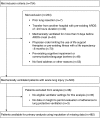Timing of low tidal volume ventilation and intensive care unit mortality in acute respiratory distress syndrome. A prospective cohort study
- PMID: 25478681
- PMCID: PMC4347437
- DOI: 10.1164/rccm.201409-1598OC
Timing of low tidal volume ventilation and intensive care unit mortality in acute respiratory distress syndrome. A prospective cohort study
Abstract
Rationale: Reducing tidal volume decreases mortality in acute respiratory distress syndrome (ARDS). However, the effect of the timing of low tidal volume ventilation is not well understood.
Objectives: To evaluate the association of intensive care unit (ICU) mortality with initial tidal volume and with tidal volume change over time.
Methods: Multivariable, time-varying Cox regression analysis of a multisite, prospective study of 482 patients with ARDS with 11,558 twice-daily tidal volume assessments (evaluated in milliliter per kilogram of predicted body weight [PBW]) and daily assessment of other mortality predictors.
Measurements and main results: An increase of 1 ml/kg PBW in initial tidal volume was associated with a 23% increase in ICU mortality risk (adjusted hazard ratio, 1.23; 95% confidence interval [CI], 1.06-1.44; P = 0.008). Moreover, a 1 ml/kg PBW increase in subsequent tidal volumes compared with the initial tidal volume was associated with a 15% increase in mortality risk (adjusted hazard ratio, 1.15; 95% CI, 1.02-1.29; P = 0.019). Compared with a prototypical patient receiving 8 days with a tidal volume of 6 ml/kg PBW, the absolute increase in ICU mortality (95% CI) of receiving 10 and 8 ml/kg PBW, respectively, across all 8 days was 7.2% (3.0-13.0%) and 2.7% (1.2-4.6%). In scenarios with variation in tidal volume over the 8-day period, mortality was higher when a larger volume was used earlier.
Conclusions: Higher tidal volumes shortly after ARDS onset were associated with a greater risk of ICU mortality compared with subsequent tidal volumes. Timely recognition of ARDS and adherence to low tidal volume ventilation is important for reducing mortality. Clinical trial registered with www.clinicaltrials.gov (NCT 00300248).
Trial registration: ClinicalTrials.gov NCT00300248.
Keywords: acute lung injury; artificial respiration; prospective studies; tidal volume.
Figures



Comment in
-
Lung-protective ventilation in acute respiratory distress syndrome. How soon is now?Am J Respir Crit Care Med. 2015 Jan 15;191(2):125-6. doi: 10.1164/rccm.201412-2250ED. Am J Respir Crit Care Med. 2015. PMID: 25590152 No abstract available.
References
-
- Brower RG, Matthay MA, Morris A, Schoenfeld D, Thompson BT, Wheeler A The Acute Respiratory Distress Syndrome Network. Ventilation with lower tidal volumes as compared with traditional tidal volumes for acute lung injury and the acute respiratory distress syndrome. N Engl J Med. 2000;342:1301–1308. - PubMed
-
- Fan E, Needham DM, Stewart TE. Ventilatory management of acute lung injury and acute respiratory distress syndrome. JAMA. 2005;294:2889–2896. - PubMed
-
- Putensen C, Theuerkauf N, Zinserling J, Wrigge H, Pelosi P. Meta-analysis: ventilation strategies and outcomes of the acute respiratory distress syndrome and acute lung injury. Ann Intern Med. 2009;151:566–576. - PubMed
-
- Petrucci N, Iacovelli W. Lung protective ventilation strategy for the acute respiratory distress syndrome. Cochrane Database Syst Rev. 2007;(3):CD003844. - PubMed
-
- Needham DM, Colantuoni E, Mendez-Tellez PA, Dinglas VD, Sevransky JE, Dennison Himmelfarb CR, Desai SV, Shanholtz C, Brower RG, Pronovost PJ. Lung protective mechanical ventilation and two year survival in patients with acute lung injury: prospective cohort study. BMJ. 2012;344:e2124. - PMC - PubMed
Publication types
MeSH terms
Associated data
Grants and funding
LinkOut - more resources
Full Text Sources
Other Literature Sources
Medical

